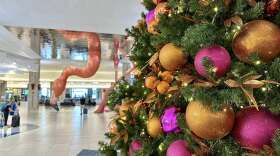In episode two of “Forgotten Park," we dive into the traditions of Glades County's annual Cane Grinding Festival, and uncover the legacy of Larry R. Luckey and the surprising archaeological revelations tied to Ortona Indian Mound Park.
The park’s official name is, “Larry R. Luckey’s Ortona Indian Mound Park.” But who is Larry Luckey? And why is this historically significant site named after him?
🔊 Listen to Forgotten Park Episodes 1-5
Larry Luckey was a Glades County property appraiser from 1984-2021. Today he lives about a 10-minute drive from the park.
He invited me to his home for a glass of sweet tea.
Luckey's family has deep roots in central Florida, spanning nearly five generations.
“Glades County is the most beautiful county in all of Florida. This is a very rural county, and it's mostly agriculture. A lot of citrus is grown in Glades County. A lot of sugarcane for sugar is grown here," said Luckey.
Each year in Glades County, the Cane Grinding Festival takes visitors back to the late 1800s, when Florida settlers cultivated and processed sugarcane.

Today, about half of the cane sugar produced in the U.S. comes from Florida. That’s nearly 20% of all sugar consumed in the country. Sugarcane is grown on land along the southern half of Lake Okeechobee.
Growing up in Glades County, Luckey says that grinding sugar cane was a necessity long before it was commercialized.
“Without sugarcane, there was no sweetening for my ancestors. I mean, you couldn't find enough honey trees, “bee trees” they called them, for sweetening.”
As a child, he remembers visiting his grandparents' home, where a portion of their property was dedicated to sugarcane.
It was a time when families relied on each other to turn the sugarcane into edible syrup.
“If they didn't have the grinder to take care of it, well, then there was always a neighbor and there was somebody in your neighborhood and you took your cane over. They squeezed it and made syrup out of it.”

That community spirit continues through the Cane Grinding Festival held on the first Saturday every February since 1979.
The original cane festival was a fish fry fundraiser to help create Ortona’s first fire department.
Dorinda Williams-Campos recalls how far a fire truck would need to travel before reaching Ortona.
“If you had a fire out here, it [a fire truck] had to come all the way from LaBelle or from Moore Haven. Labelle was like 12 miles and Moore Haven is 14 or 15,” she said.
Her father Marvin Williams, and other major landowners in Ortona at the time, pooled their resources to make the festival bigger and better each year.

“They put up some makeshift outside toilets, you know, handmade porta Johns. And they made a little platform so that we could have singers. And we got a bluegrass band from Labelle,” said Williams-Campos.
A young Dorinda also lent a helping hand at a make-shift market.
“They built a little shaky-looking thing, and I remember about two o'clock in the morning, they said, 'you know, we need to sign on that.' So, they brought me an old rough piece of wood and I wrote ‘Country Store,’ and they nailed it up there,” said Williams-Campos.
"We sold the cane syrup, and we sold cakes, and stuff that the ladies had made, and just different things out of that.”
In 1987, Larry Luckey obtained a Florida grant to establish a permanent park and venue for the festival.
“The park is where the old original Ortona dump was," said Luckey. "Well, I wanted to move all that out.”
“I found out that the county owned that piece of property. And I said, ‘Oh, wouldn't it be wonderful to have a place for a park.’ And twofold, the historical remains, because lots have been destroyed, of the Indian mounds are still there. And then it'd be a place to go in and have a festival.”

I asked Larry if people living in Ortona knew about the mounds.
“Nobody in Ortona knew much about that, except me and few, maybe three or four,” Larry said.
He says since the land is owned by Glades County, no one outside of local government knew much about the the property.
"Nobody else really understood it and knew the significance," Larry said.
"That's when I called Bob Carr.”
In episode three, throughout Ortona Indian Mound Park, large mounds and canals hand-dug by native people can still be found, yet no signs or markers identify them.
We'll meet archaeologist Bob Carr who reveals the significance of Ortona’s almost forgotten, native earthworks. What he shares challenges traditional understandings of native capabilities and permanently alters history.
WGCU is your trusted source for news and information in Southwest Florida. We are a nonprofit public service, and your support is more critical than ever. Keep public media strong and donate now. Thank you.








